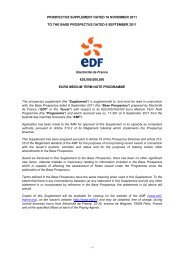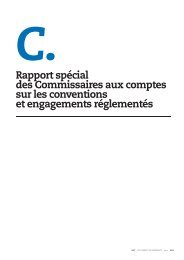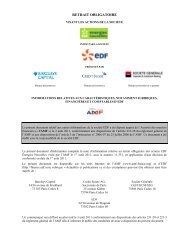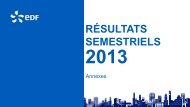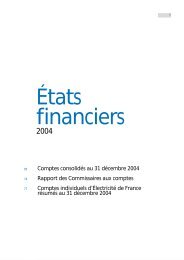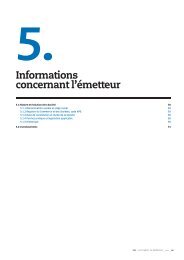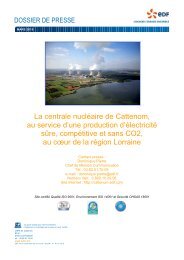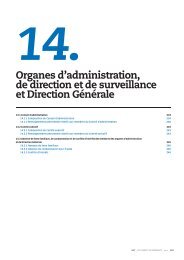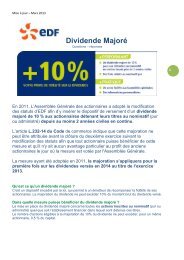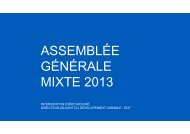Under the Euro Medium Term Note Programme ... - Finance - EDF
Under the Euro Medium Term Note Programme ... - Finance - EDF
Under the Euro Medium Term Note Programme ... - Finance - EDF
You also want an ePaper? Increase the reach of your titles
YUMPU automatically turns print PDFs into web optimized ePapers that Google loves.
Risk Factors<br />
Risks associated with <strong>the</strong> <strong>EDF</strong> Group’s activities<br />
The <strong>EDF</strong> Group operates facilities that may cause significant harm to <strong>the</strong> natural or<br />
human environment or for which accidents, natural disasters or external attacks may<br />
have serious consequences<br />
The risks specific to nuclear facilities are described separately below (“Specific risks related<br />
to <strong>the</strong> <strong>EDF</strong> Group’s nuclear activities”).<br />
Although <strong>the</strong> <strong>EDF</strong> Group is not <strong>the</strong> owner of hydropower facilities, but only a concession<br />
holder, as <strong>the</strong> operator <strong>the</strong>reof, it is responsible for <strong>the</strong> safety of <strong>the</strong> facilities. The main risks<br />
associated with hydropower facilities and <strong>the</strong>ir operations are <strong>the</strong> risk of dams or associated<br />
hydropower facilities bursting, risks associated with operating <strong>the</strong> facilities during floods, <strong>the</strong><br />
risk associated with flow or level variations due to <strong>the</strong> operation of <strong>the</strong> facilities and risks<br />
related to natural disasters, external attacks or malicious acts of any kind. During <strong>the</strong><br />
construction and operation of hydroelectric facilities, <strong>the</strong> <strong>EDF</strong> Group takes necessary<br />
accident prevention and safety measures in conjunction with <strong>the</strong> public authorities.<br />
None<strong>the</strong>less, <strong>the</strong> <strong>EDF</strong> Group cannot guarantee that such events will never occur or that <strong>the</strong><br />
measures taken will be fully effective in all cases, in particular, in dealing with external events<br />
(floods, natural disasters, negligence or malicious acts).<br />
Persons working in or near electricity transmission and distribution facilities may, in <strong>the</strong> event<br />
of an accident, error or negligence, be exposed to <strong>the</strong> risk of electrocution. In this field, <strong>the</strong><br />
<strong>EDF</strong> Group also implements accident prevention and safety measures. However, <strong>the</strong> <strong>EDF</strong><br />
Group cannot guarantee that <strong>the</strong>se measures will prove sufficient in all cases.<br />
Questions concerning <strong>the</strong> risks to human health from exposure to electromagnetic fields<br />
(EMF), in particular, from power lines operated by <strong>the</strong> <strong>EDF</strong> Group, have been raised both in<br />
France and abroad. Based on studies completed over <strong>the</strong> past 20 years, numerous<br />
international health organisations (including <strong>the</strong> World Health Organisation (WHO), <strong>the</strong><br />
International Agency for Research on Cancer (IARC), <strong>the</strong> American Academy of Sciences,<br />
<strong>the</strong> American National Institute of Environmental Health Sciences (NIEHS) and <strong>the</strong> UK<br />
Health Protection Agency) consider, based on currently available scientific information, that<br />
<strong>the</strong> existence of health risks due to exposure to EMFs has not been proven. Various reports<br />
published in 2009 (Scientific Committee on Emerging and Newly Identified Health Risks<br />
(SCENIHR)) and 2010 (AFFSET and OPECST) do not change <strong>the</strong>se conclusions. Since<br />
2002, <strong>the</strong> IARC has classified low-frequency electromagnetic fields at level 2B (possible<br />
carcinogen) on its scale of scientific evidence. In addition, in a report published in June 2007,<br />
<strong>the</strong> World Health Organisation considers that health risks, if any, are low. In 2010, RTE, in<br />
conjunction with <strong>the</strong> French Mayor’s Association, launched an information and measurement<br />
campaign on <strong>the</strong> subject of very low-frequency (50Hz) electromagnetic fields for <strong>the</strong> mayors<br />
of 18,000 municipalities located near high and very high voltage power lines. This joint<br />
campaign reinforces existing communication on EMFs and aims to respond openly to <strong>the</strong><br />
questions most frequently asked on <strong>the</strong> subject. Medical knowledge about health risks<br />
related to exposure to EMFs may evolve, public sensitivity about such risks could increase or<br />
<strong>the</strong> precautionary principle could be applied very broadly. At both <strong>the</strong> EU and French level,<br />
new regulations aimed at understanding <strong>the</strong> risks associated with EMFs are being drafted.<br />
For example, in France, <strong>the</strong> Grenelle 2 law of 12 July 2010, and its implementing decree of 1<br />
December 2011, provide that as of 1 January 2012 managers of public electricity<br />
-39 -



